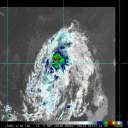Show Selection:
|
#942221 (Received by flhurricane at: 5:00 PM 28.Sep.2018)
TCDAT3
Subtropical Storm Leslie Discussion Number 10
NWS National Hurricane Center Miami FL AL132018
500 PM AST Fri Sep 28 2018
Central convection associated with Post-Tropical Storm Leslie has
gradually increased during the last couple of days and is now
organized into a group of bands that wraps most of the way around
the center. In addition, scatterometer data show that the cyclone
has lost much of its large baroclinic wind field, and that the
radius of maximum winds has contracted from 120-180 n mi yesterday
to 90 n mi or less today. While the storm has also developed a warm
core and shed some of its baroclinic characteristics, it is embedded
in a large deep-layer low pressure system, and thus it is designated
subtropical instead of tropical. The initial intensity is set at 45
kt based on the scatterometer data.
Leslie has been moving generally westward for the the past few
days. The large-scale models forecast a general southwesterly
motion for the next 3-4 days as the cyclone is steered by a segment
of the subtropical ridge to its west and another large deep-layer
low forming to its east over the eastern Atlantic, with a decrease
in forward speed near the end of the forecast period as the ridge
to the west weakens. The forecast guidance is tightly clustered
through 120 h, and the forecast track is near the center of the
guidance envelope and the consensus models.
The forecast track takes the center of Leslie over increasing sea
surface temperatures during the next several days, although the
temperatures may not be as warm as those indicated in the SHIPS
model. The global models suggest that little change in strength
will occur during the first 48-72 h as Leslie gradually develops
the upper-level outflow pattern of a tropical cyclone and
transitions to a tropical storm. After that time, they are in good
agreement that the cyclone will strengthen. Based on this, the
intensity forecast shows only modest intensification during the
first 48 h, followed by strengthening to a probably conservative
60 kt. The forecast also calls for transition to a tropical storm
between 48-72 h, with the caveat that this could occur earlier.
FORECAST POSITIONS AND MAX WINDS
INIT 28/2100Z 36.1N 48.1W 45 KT 50 MPH
12H 29/0600Z 35.4N 49.6W 45 KT 50 MPH
24H 29/1800Z 34.4N 51.2W 45 KT 50 MPH
36H 30/0600Z 33.8N 52.2W 50 KT 60 MPH
48H 30/1800Z 33.2N 53.1W 50 KT 60 MPH
72H 01/1800Z 32.5N 54.5W 55 KT 65 MPH...TROPICAL STORM
96H 02/1800Z 31.0N 56.0W 60 KT 70 MPH
120H 03/1800Z 31.0N 57.0W 60 KT 70 MPH
$$
Forecaster Beven |



